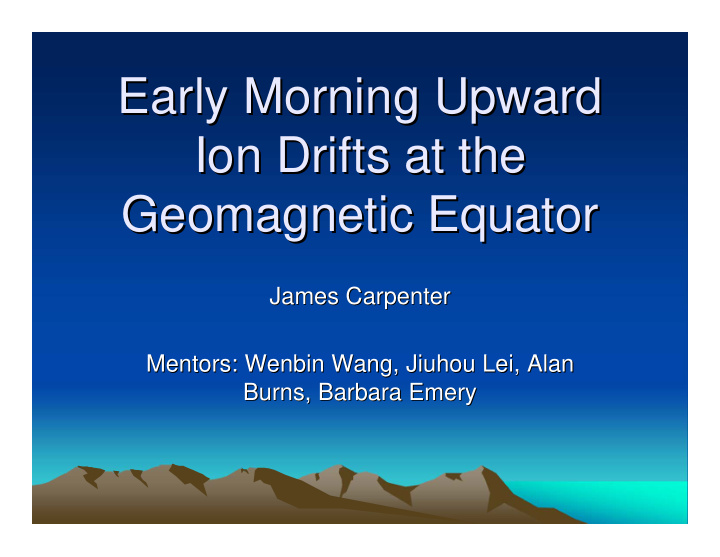



Early Morning Upward Early Morning Upward Ion Drifts at the Ion Drifts at the Geomagnetic Equator Geomagnetic Equator James Carpenter James Carpenter Mentors: Wenbin Wang, Jiuhou Lei, Alan Mentors: Wenbin Wang, Jiuhou Lei, Alan Burns, Barbara Emery Burns, Barbara Emery
What in the World are Ion What in the World are Ion Drifts? Drifts? • In the ionosphere, particles are subject to forces exerted by electric and magnetic fields, and their motion is influenced. • This study focuses on the vertical motions of the ions in the ionosphere. Velocities are averaged over 360 km.
How do we measure drifts? How do we measure drifts? • Through the use of ISR, vertical motions of the ions can be measured. • Data from Jicamarca (pictured right) was used for this correlation study. http://jicamarca.ece.cornell.edu • Data was taken from CEDAR database and analyzed for drifts.
ISR… …Horribly Simplified Horribly Simplified ISR A radar beam is propagated from an antenna into the ionosphere. Instead of hitting a single ‘hard’ target, the beam encounters large numbers of electrons which are randomly moving. This reflects the signal over a spectrum of frequencies near the transmitted frequency.
ISR ISR • Incoherent Scatter Radar tells us the following information about the ionosphere: • Electron Density • Electron/Ion Temperature You’re Welcome. • Ion composition • Vertical, Zonal Electric Fields (in the equatorial ionosphere) • Motion of Ions.
Peculiar Behaviors in the Drifts Peculiar Behaviors in the Drifts Out of 224 useful days of data spanning Jan. 1984 to Oct. 2008, there were 116 “Events” (displaying the behavior) and 108 Non-Events.
Finding a Correlation Finding a Correlation • We are comparing the drift behaviors to certain geophyiscal parameters such as: • IMF (Bz, By) � • Kp • F10.7 • Also looking for any seasonal dependence, effects from solar wind (speed and proton density), etc.
Is there a Seasonal Is there a Seasonal Relationship? Relationship? Seasonal Variation 50 45 40 35 30 Events 25 Non-events 20 15 10 5 0 Winter Spring Summer Fall
What about kp? What about kp? Dependence on kp-values 80 70 60 50 Events 40 Non-events 30 20 10 0 0-2.3 2.7-4.3 >4.3
Or F10.7? Or F10.7? Dependence on f10.7 values 80 70 60 50 Events 40 Non-events 30 20 10 0 <100 100-150 151-200 >200
An interesting observation… … An interesting observation
The Trouble with Timing. The Trouble with Timing.
Hourly Data Hourly Data
Do the Drifts Mimic Bz? Do the Drifts Mimic Bz? • Spanning the data, there are 177 days that contain Bz data that can be compared to the drift. • Of these 177 days, 107 (60.5%) appear to follow the behavior of Bz. • The remaining 70 days (39.5%) do not show a discernible similarity to Bz.
Relationships with Bz and f10.7 Relationships with Bz and f10.7 • Occurrences of the “events” decrease sharply with increasing F10.7 values, with the vast majority occuring at F10.7 values less than 100. • There are 108 days of data with an F10.7 value less than 100. • Of these, 89 days contain Bz data to compare.
Relationships with Bz and f10.7 Relationships with Bz and f10.7 • 37 Events that mimic Bz (41.6%) � • 18 Events that do not mimic Bz (20.2%) � • 19 Non-Events that mimic Bz (21.3%) � • 15 Non-events that do not mimic Bz (16.9%) �
5-minute Data 5-minute Data
Using the 5-minute Data Using the 5-minute Data • OMNIweb has 5-minute data spanning back to 1995. • At the last possible minute, this data was collected and plotted in anticipation of finding the same behaviors. • There are now 4 distinct drift behaviors prevalent in the 5-minute data.
IMF (ACE) Case 1 Case 1
Case 2 Case 2
Case 3 Case 3
Case 4 Case 4
Patterns Patterns • When the change in Bz is around 5-10 nT, the upward drifts are usually noticed in conjunction. • When the change in Bz is very small, sometimes the drifts occur, and sometimes they do not. • Changes in Bz greater than ~10 nT seem to correspond with the appearance of “bubbles” in the drift data. • Rarely, there is a significant change in Bz, but no noticeable shift in the behavior of the drifts.
Next Questions Next Questions • Electric field penetrations may be a likely cause for the drifts. – Why do they not occur all the time for smaller changes in Bz? • F2 peak electron density may be too high or low to permit upward drifts. • The topside gradient may be too small or large. – Why do the penetrations appear to be most effective at night? – These can potentially be examined using CMIT.
also Horribly Simplified
Convection Electric Field (Magnetospheric) Ionospheric Electric Field due to dynamo action of neutral atmosphere
Magnetospheric Electric Field Ionospheric Electric Field due to dynamo action of neutral atmosphere Upward Drifts?
Next Steps… … Next Steps • Compare the drift and Bz behaviors with the electron density profiles to discern any potential relationship. • Determining causality will require much more study. • Use CMIT to investigate the drifts and any influences on them from the magnetic field.
Recommend
More recommend